Pathways: A new approach for women in entrepreneurship
An independent review into women in entrepreneurship in Scotland, authored by Ana Stewart and Mark Logan. Based on thorough data analysis and stakeholder engagement the report's recommendations seek to address the root causes of female under-participation in entrepreneurship.
04. Women are often logistically more constrained
"Women do not need special support, they need different support to suit their environment, it is a case for elevating equity but more importantly it is an economic case to have more women create and grow their own businesses." - Professor Norin Arshed, University of Dundee
In this chapter, we explore the following proximate cause of female under-participation in entrepreneurship:
Relative to men, women are often more logistically constrained, making participation in entrepreneurship difficult.
What are the root causes of the logistical constraints acting upon women, which make equal participation in entrepreneurship difficult?[38]
Firstly, from birth onwards, we experience intensive societal conditioning on what constitutes "normal" gender roles. The second is that the education programmes – from birth to adulthood – required to intensively counter and correct this conditioning, are largely absent from our society.
In the context of our present focal area, these root causes combine to create three intermediate causes. Firstly, women are expected to be the primary carer. Secondly, women are expected to be the household and family manager. Finally, society doesn't provide adequate support to either of these roles sufficient for women, on average, to operate in business with the same freedoms that men, on average, enjoy.
For example, being the primary carer severely restricts working time, working flexibility and location[39]. In addition, being the household manager whilst working full time carries a significant cognitive burden in managing the rest of the family's and the home's logistics[40]. Because society traditionally (and, currently, still largely) considers that these roles are naturally the preserve of women, with men playing that of the primary bread winner within the family unit, it doesn't seem necessary to level this playing field to any great extent. So, many of our state nurseries close at 3:00pm, women are expected to take the great bulk of parental leave, and so on. In single-parent families, of which women make up 92%[41], these roles are, of course, even more concentrated.
"The odds are stacked against women succeeding in entrepreneurship because the current system has not evolved to support them." - Tim Allan, Founder, Tricorn Capital
Such pressures in turn create further intermediate effects. For example, they produce an impetus for women to seek careers and locations with greater flexibility, less risk, more accessible services and less cognitively demanding work. While not all women will respond to these intermediate causes in the same way, and will have varying personal circumstances, these combined effects overall act to reduce participation-rates in entrepreneurship for women.
Interestingly, in our interviews, the majority of the most successful and well-established female entrepreneurs reported being well supported by partners and/or their families[42] in either or both of the home manager and primary carer roles, often fully sharing responsibilities with them.
We can summarise the cause-and-effect relationships between these various mechanisms as follows (reading from bottom to top):
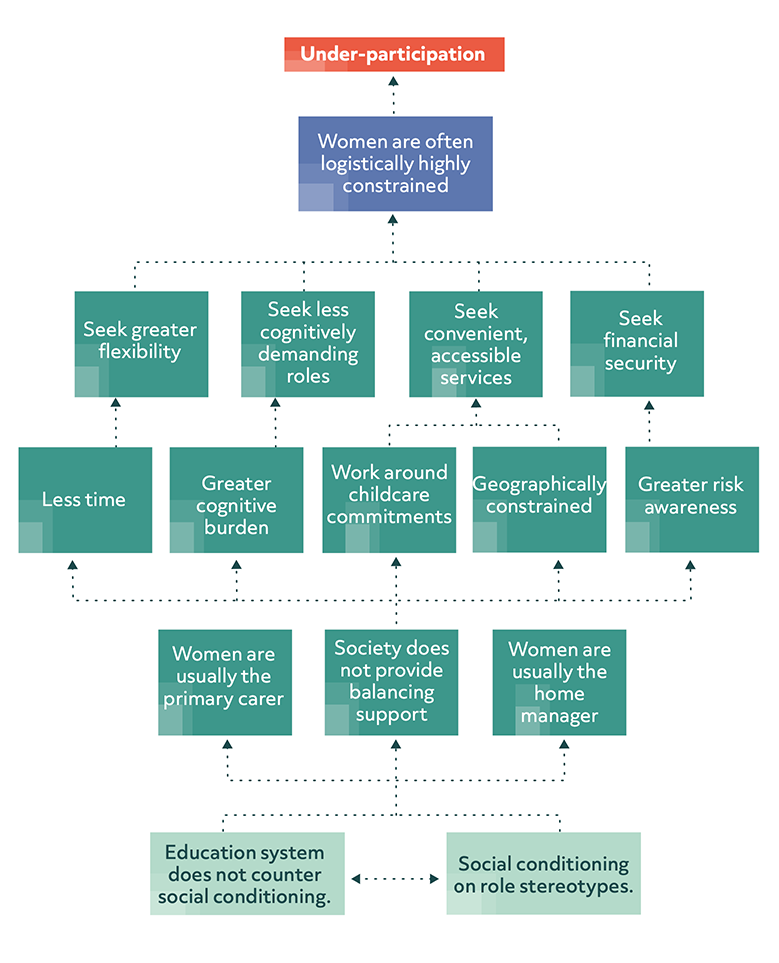
Addressing the Causes
Reducing the strength of above cause-and-effect relationships requires us to act in two areas. We must address the root causes that result in women overwhelmingly occupying the home manager and primary carer roles. And, recognizing that such actions are long-term in nature, we must also act to reduce the current consequential effects that the constraints of this allocation have upon entrepreneurial participation. We acknowledge that, although we are analysing this focal area from the perspective of women (because women are most often subject to its effects), our proposals naturally should provide the same potential for everyone engaged in primary carer and home manager roles.
From our cause-and effect tree above, we can summarise the effects resulting from the home manager and primary carer roles as: (mainly) women are constrained both in time and geography. And they carry a cognitive burden from these roles that reduces their available capacity for other activities and that heightens their general risk awareness.
"Entrepreneurs with primary care responsibilities have to overcome a massive, often prohibitive, energy barrier that others do not. This is very challenging when trying to start or scale a business". - Caroline Barelle, CEO & Founder, Elasmogen
A well-established starting point for encouraging early entrepreneurial activity is an incubation and education space of one form or another, in which founders can locate their fledgling start-ups for a period and/or receive regular mentoring and network support. The Scottish Technology Ecosystem Review[43] develops this concept into a network of "Tech-Scalers" across several city-centre locations, providing long-term incubation, high-quality, intensive founder education and a peer-learning and support environment, amongst other features, for tech start-ups.
The later paper Scotland's National Strategy for Economic Transformation[44] proposes to evolve the Tech-Scaler network in two ways. The first is to generalise the network into a Start-up Scaler Network, supporting start-ups regardless of whether they are considered to be technology companies. The second is to extend the network into the wider community, with a larger network of smaller Pre-Scalers, providing very early-stage start-ups with incubation support, access to similar educational materials as in the Start-up Scalers, and a pathway into the Start-up Scaler network.
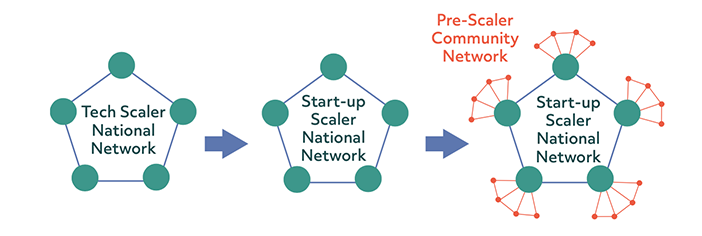
Start-ups ultimately may graduate from Pre-Scalers in different ways. Those qualifying as high-growth potential start-ups would likely move to the Start-up Scaler network, while some may access other existing support services.
Could these concepts serve as the basis for part of a solution to the constraints under examination here? The answer is yes, provided that we adapt the concept in line with the principles guiding this report's recommendations.
Recapping, Principle 3 requires that solutions work for everyone rather than being add-ons to ill-adapted solutions. Principle 4 requires that solutions can be properly and practically expanded so as to be real solutions at the scale required. With these points in mind, let's now consider how to develop the Pre-Scaler concept to be practically useful in the context of the logistical constraints placed on potential founders who also occupy the home manager and/or primary carer roles.
From Pre-Scaler to Pop-up Pre-starts (PUPS)
The significant additional burden placed upon primary carers means that, for many, they are time-poor and location-constrained. They require to move radially around urban centres, or within rural areas, in a "trip-chained" manner[45]. They generally don't have the time to travel to major urban centres and back again. The home, workplace, school, nursery, shopping centre, surgery, etc. need to be close enough to each other to be accessible within the time constraints in which primary carers typically operate. Therefore, all are generally located at the same radial distance from the urban centre, for example. To attempt to deviate much from this radial journey is to considerably exacerbate the time constraint, reducing available working time and adding to the mental burden through increased time-driven anxiety. In our interviews with female entrepreneurs , the childcare burden was regularly highlighted as a particularly challenging constraint. These factors act to reduce the accessibility of start-up incubation and entrepreneurial education services for primary carers.
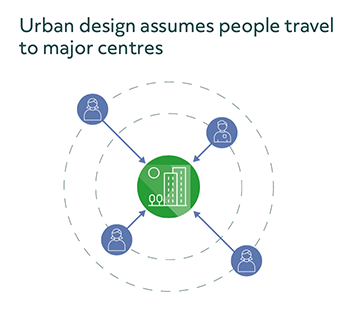
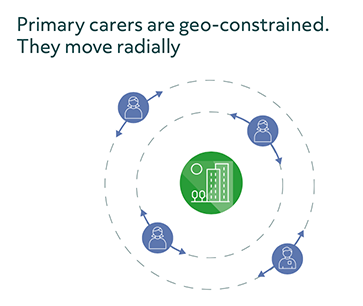
Thus, the Pre-Scaler concept is helpful here because Pre-Scalers can be located at various radial distances from the urban centre. But it is problematic to deliver the number of Pre-Scalers required to satisfy potential demand from primary carers for access to incubation resources whilst still allowing them to move radially. Not only must we grapple with the considerable delivery cost involved at scale, but it is also very difficult to provide quality mentoring support to a large number of Pre-Scalers.
These problems can be overcome by extending the Pre-Scaler concept from a fixed location to a mobile, pop-up format, and this is what we recommend in this report. Pre-Scalers should be delivered both as fixed locations (as previously discussed in NSET[46]) and also in a pop-up format from the outset. Pop-up locations must be where primary carers already are, for example, utilising empty retail spaces in shopping centres, community colleges, schools, libraries and similar locations[47].
We also note that the term Pre-Scaler is not properly descriptive of the types of early-stage businesses that would likely use them. Certainly, some of the companies that are supported in their early stages in this environment will go on to significant scale. But many others, though collectively very important to the nation's economy, will not. Indeed, for that reason, the term Pre-Scaler may dissuade many early-stage founders from approaching the service in the first place. Therefore, we propose to change the name Pre-Scaler to Pre-Start centres (or, Pre-starts, for short). The Pop-up variant, which is the main focus of this discussion, will therefore be referred to as Pop-up Pre-starts (or PUPS). And, when we refer to Pre-start centres and Pop-up Pre-starts collectively, we'll use the term Pre-starts network.
A PUPS would remain at a given location for anything from a couple of days to a week to a month, depending on demand and other factors, and it would return to that location frequently and predictably. The PUPS would provide an incubation environment for developing a start-up concept with both general business mentoring support and access to digital marketing expertise (for example website building, search engine optimisation[48], social media advertising advice, etc.) and related areas.. It would provide a networking and confidence-building peer-learning opportunity. And it would provide shared virtual access to resources such as 3D printing machines, and similar design tools.
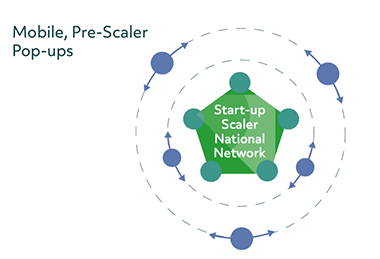
Such an approach, which is an extension of a concept pioneered by Elevator's successful E3 initiative, carries several advantages. The model makes efficient use of funding and our limited number of capable mentors and other required personnel in delivering the service to the greatest number of participants. Locations that work can be easily identified through direct, learned experience. Where a particular location is especially popular over a sustained period, it can be considered for conversion to a permanent Pre-start centre. Utilising retail locations and other under-used spaces would bring a little more life back to our local retail areas.
This model has applicability well beyond the needs of primary carers. It makes support available to all groups with time and location constraints. For the same reason, the concept is ideally suited to supporting rural entrepreneurship.
The above proposal is helpful in addressing the geographical constraint and, as a consequence, helps to some extent with the time constraint issue too. But we can also further address the time constraint problem by building upon the Pre-starts/PUPS model so far outlined.
The time constraint is mainly a consequence of the primary carer role. For example, in the case of caring for children, many of our state nurseries and our schools close at 3:00pm or thereabouts. Contrast with France, for example, where the school day runs from 8:30am until 4:30pm. Meanwhile, paid childcare in the UK is the most expensive in Europe[49]. The relatively short-duration state-provided childcare provision and the relatively high cost of extended private childcare act together to severely time-constrain women living below a certain income level.
We therefore propose that the Pre-starts network (comprising fixed-location Pre-Start centres and PUPS) provides limited financial childcare support to entrepreneurs in the primary carer role as follows:
There are two available levels of membership in the Pre-starts network. Associate membership is the default membership. Anyone can come to the Pre-Start centre or PUPS for presentations, events, networking days, mentoring sessions and the like. This ensures that the tentative, the apprehensive and the curious have a relatively low bar to exploring and developing their interest and confidence.
"Scotland should be supporting women, especially mothers, to combine raising children with running a business. In Germany it costs less than £250 per month to have a child in full-time care." - Petra Wetzel, Founder West Brewery
A subset of associate members will move to Full Membership, this membership level being re-assessed on an annual basis. Full Members are Associate Members whose start-up concept or stage of development is considered by the Pre-start centre or PUPS operator to be promising enough to merit full entry to the network. Full Membership carries benefits, including access to some of the more advanced Start-up Scaler training programmes. And it also includes a grant intended to meet the costs of several hours per week of extended childcare, for up to a period of one year. To ensure that budgeting is predictable, the central operator (see below) is responsible for ranking in order all start-up concepts across the network and allocating Full Memberships according to this ranking and available budget limits in any given year.
For delivery purposes, we propose a model whereby there exists a Central Operator of the overall Pre-starts network, including the Pop-up variant. The Central Operator would then work with Franchise Operators around the country to deliver the network. We envisage that the Franchise Operators would be largely drawn from existing organisations, who would adapt their services to meet the requirements of the Pre-starts network - Scotland currently has a variety of organisations providing variations on subsets of this concept. In selecting Franchise Operators, it is important not to specify their operating models with excessive rigour, or otherwise overly-constrain them, as most are successful precisely because of their ability to adapt to local conditions and priorities. It is sufficient to ensure that Franchise Operators deliver a minimum-specified service footprint within their wider service mix.
This Central Operator/Franchise Operator model encourages a more collaborative approach between existing organisations in delivering the benefits of the Pre-starts network. It utilises their energy and experience across the country whilst ensuring consistency and minimum standards of delivery. The Central Operator would also be responsible for managing central processes (such as Full Membership processes) and resources (such as 3D printer access, digital marketing expertise, etc.).
Together, Central and Franchise Operators are responsible for actively reaching out to under-represented demographics, and for working to tightly integrate the network with existing central and regional entrepreneurial resources and partner offerings.
To Scale-Up or to Scale-Deep?
What if we didn't implement the pop-up model proposed here or, for that matter, the fixed-location Pre-starts network?
For many years, there has existed a policy debate in Scotland as to whether to focus on creating more unicorn companies (to scale-up), or instead on local and community entrepreneurship (to scale-deep). Over decades, industrial policy has favoured one or other of these positions, but not both.
The authors' view is that both forms of entrepreneurship have a symbiotic dependency, and that to focus on only one of them is detrimental to our ambitions for the other. It is a myopia that renders our national strategy for entrepreneurship incomplete and incoherent. It's akin to attempting to grow Giant Redwoods without also nurturing the forest floor that brings them forth.
High-growth start-ups will emerge more often in a country that exhibits a general culture of entrepreneurship and that is at ease within that culture. They will rarely emerge from an otherwise sterile entrepreneurial landscape. To create such a fertile entrepreneurial environment, the nation must continually build-out and strengthen its entrepreneurial support network.
We can think of that network as consisting of three (connected) subnetworks, or layers. The first is the Central Entrepreneurial Network (CEN). It combines our existing incubation, founder-education and other support frameworks, both government-backed and private. These are largely located in the centres of cities or large towns. It's from these environments that scale-ups and unicorns are most likely to ultimately emerge.
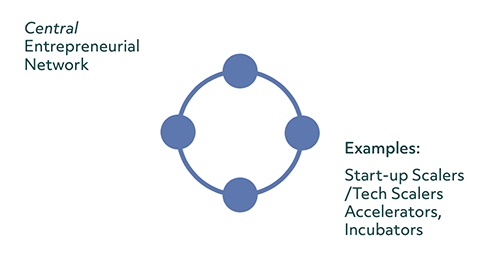
The second network is the Regional Entrepreneurial Network (REN). This extends the above capabilities into suburban and, to some extent, semi-rural areas. In this layer, we are beginning to reach an entrepreneurial constituency that is a combination of future Scale-up founders and Scale-Deep founders.
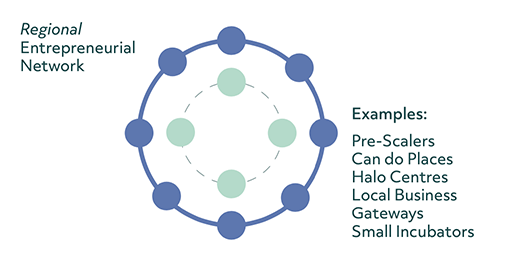
The overall entrepreneurial network is completed by the Pop-up Entrepreneurial Network. This layer includes the Pop-up Pre-starts model proposed in this section as well as similar existing mobile services, such as Elevator's E3[50] initiative, and the work done by Growbiz[51] (in supporting rural entrepreneurship). This layer enables us to cost-effectively enfranchise more of the population in entrepreneurial opportunity, including primary carers, as discussed above.
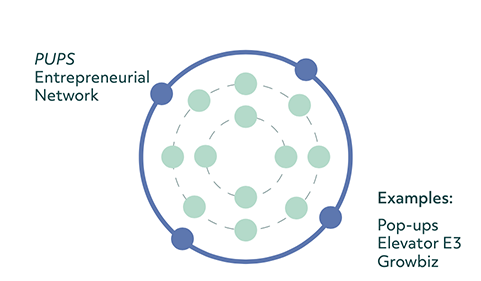
The symbiosis between Scale-ups and Scale-Deeps operates as follows: by expressing the full entrepreneurial network in this way, we encourage far more people into the field, making it more likely that we will discover founder talent, including those with scale-up potential. And businesses can be nurtured in the outer Scale Deep network layers, with an appropriate subset proceeding towards the more Scale-Up oriented support provided in the central layer.

Meanwhile, more headline Scale-Up entrepreneurial success stories create belief and excitement within the entrepreneurial ecosystem as a whole, which encourages more people to become entrepreneurs.
But nurturing the Scale-Deep category of businesses also conveys other significant benefits to society. The product or service provided by a Scale-Deep business almost always provides a direct economic or societal benefit to the location in which the business is situated. This same is only sometimes true of Scale-Ups (their main societal benefits being employment and tax revenues).
And Scale-Deeps almost always create jobs within distributed communities, including rural areas across Scotland, whereas Scale-Ups usually only do so within large population centres, notwithstanding recent hybrid working models.
In short, Scale-Deeps directly raise the country's wellbeing index and reduce its social security bill. They are an integral part of a functioning, successful society. The Pop-Up proposal presented here simply enfranchises more of our citizens within the country's entrepreneurial ecosystem, which both improves the economic performance and individual opportunity.
The overall effect of the above recommendations is to establish in Scotland an integrated nationwide entrepreneurial incubation, education and support platform, and one that is properly adapted to the needs of under-represented demographics. To ensure that we stay true to these goals during implementation and beyond, we recommend that the design and development of this platform includes regular input and consultation with a panel of founders from under-represented demographics.
Addressing the Root Causes
The foregoing discussion addresses the 'consequences' of the home manager and primary carer roles typically being assigned to women. But what about the causes of that assignment? The following is an extract from our earlier cause-and-effect tree in this chapter, depicting only the bottom of the tree.
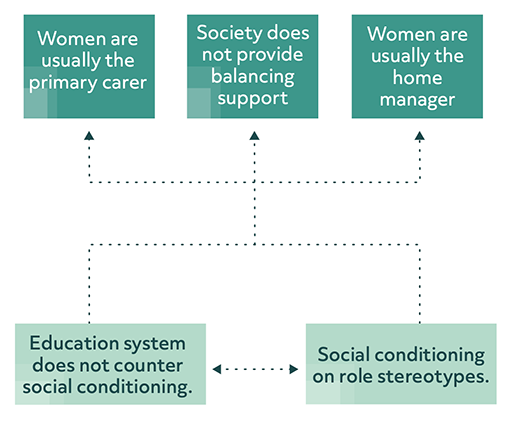
The interventions discussed above can mitigate the constraints of time and geography to only a limited extent, while the cognitive burden resulting from them remains largely unchanged.
Further improvement requires that society dismantle its own role stereotypes associated with the primary carer and home manager role. Of course, the rewards to doing so extend far beyond the entrepreneurial field, into general industry and society as a whole.
Such a change requires an intensive educational/awareness programme continuing over many years, targeted not only at children, but at adults and businesses too. This multi-pronged approach is very important. There is limited utility in teaching children at school about shared carer and home manager responsibilities if they return home to see role stereotypes being reinforced by parents or carers. Nor is much gained if enlightened parents discover that their employers frown upon men who "take too much parental leave".
An educational programme can be integrated relatively easily at school level, within existing personal development curriculum slots. Such programmes obviously must include on-going, training for teachers in topics such as anti-sexist and anti-racist approaches.
A continuous, multi-channel public information campaign should be developed, educating its audience on the concept of the mental load borne by those acting in the home manager role and primary carer roles.
Of course, it is entirely unlikely that such an approach, even sustained over years, will change everyone's attitudes and consequent behaviour. But this isn't the goal. If the centre of the distribution of attitudes can be shifted, this represents a considerable improvement across society as a whole (equal to the shaded area on the chart, below).
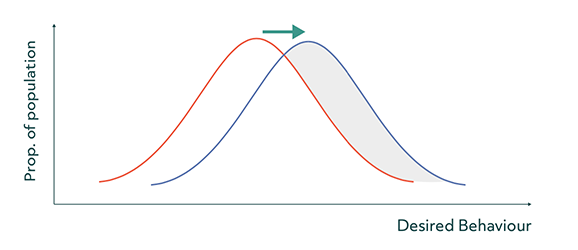
It's obvious that attempting to change the role stereotypes associated with women is a useless endeavour if we don't, in parallel, change those stereotypes that attach to men. Prospective female entrepreneurs will make little progress if their male partners must meanwhile adhere to the primary-breadwinner stereotype inside their workplaces, for fear of otherwise being penalised in their careers.
In this respect, it is therefore imperative that employers also adjust their attitudes. Although the right to shared parental leave was introduced in the UK several years ago, the vast majority of men still take only a fraction of their entitlement. Men are often regarded as "less committed to the business" if they take on a greater proportion of the carer role or if they take more than a couple of weeks of parental leave.
The government naturally does not control the culture inside organisations, while tax-based incentivisation is a somewhat clumsy influencing method at this relatively fine level of cultural granularity. Instead, we propose to build upon the Scottish Government's existing Fair Work Framework, that promotes a fair working environment within the nation's businesses, currently guided by five focal areas[52].
Our proposed extension recognises that employers not only shape the culture of their own organisations, they also influence wider society through the effect that workplace culture has on those with whom an employee has relationships. For example, in a heterosexual couple, the level of tolerance/encouragement that a business demonstrates towards a male employee who wishes to use his shared paternity entitlement directly influences the scope that his partner has to pursue her own career goals, including, of course, any entrepreneurial ambitions that she may have.
We propose that a Fair Society Champion accreditation is introduced in Scotland, awarded to those employers that actively encourage a fairer society. For example, the employer:
- Actively encourages men to take up their full parental leave.
- Actively encourages men as well as women to take on carer responsibilities, providing flexibility with regards to working hours pattern and location.
- Regularly educates employees with regard to the home manager and primary carer burden.
- Instigates processes and training to reduce the likelihood that primary carers, including men, are penalised or regarded as "not committed".
To encourage uptake of this accreditation, suppliers to government would be required to hold this accreditation, or be working towards doing so within a limited time-period, if they wish to continue working on government-awarded contracts. This is consistent with the approach taken as regards the other principles of the Fair Work Framework.
The above proposals are presented as specific recommendations in Chapter 10: Consolidated Recommendations.
Contact
Email: EIDEEBSPEnquires@gov.scot
There is a problem
Thanks for your feedback